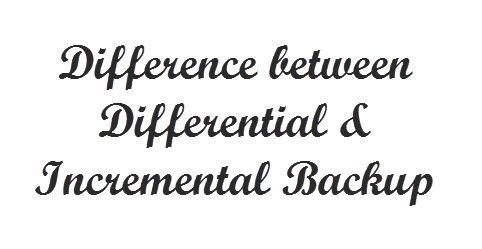Backup’s are very important for the smooth working of every environment and even for home users. There are different methods by which we can take backup of our servers, whether it is UNIX or Windows based, methods remain the same for backup. This article will give you information about differential and incremental backups and you will be able to make the difference between both.

Before talking about the differences between Differential and Incremental backup, we would like to tell about full backup.
Prior to differential and incremental backup techniques, we used to use the full backup technique only. In full backup, all the data which is under backup schedule is backed up and if you run a full backup daily then the whole of the backup is done daily whether the data is changed or not.
Recommended Article: Content Addressed Storage (CAS)
The disadvantage of a full backup is that it takes lots of space for storing the backup, and takes a long time to take backup.
Suppose you have 10 TB of data and out of it only 1GB of data is only changing daily, but full backup will backup 10 TB of data daily and thus increasing the size of the backup. It may also lead to the storage crunch.
Full backup is only advised once a month or if data is very critical it can be scheduled on a weekly basis. The main advantage of the full backup is that it takes less time to restore.
What is Differential Backup?
As we studied above, that full backup has the disadvantage of producing storage crunch thus we also use differential backup in our backup schedule.
Differential backup are those which backup files which are changed from last good full backup. It will create copies of all the files that have changed from the ones in the full backup and when it’s run again on another scheduled time it will pick up changed files again since the full backup.
For example, if your full backup completed on Monday, then the Differential backup will take files that have been changed since last full backup i.e. Monday and if you run your differential backup on Wednesday, then again differential backup would take backup from the last good backup plus the backup from Tuesday.
Means it would backup all the files which are changed since last full backup, even if they have been already backup on other backup schedule and we can say that their checkpoint is a full backup.
The advantage of differential backup is that it takes less time than the full backup to complete and also use less space for backup. The disadvantage of differential backup is that it will take more time to restore the backup as it will first require full backup and then the latest differential backup to restore the data.
It is also known as cumulative incremental backups, so don’t get confused with the incremental backup.
What is Incremental Backup?
Incremental backup also called “differential incremental backups” and backup changed files or data similar to differential backup, but they start back up from the last full backup or incremental backup.
If incremental backup is available, full backup is ignored while taking backup. Suppose you have a full backup on Monday, then Tuesday incremental backup will backup only backup files which are changed after a full backup. Now when the next incremental backup will run, it will start backing files which are changed from last good incremental backup i.e. of Tuesday.
The advantage of an incremental backup is that it takes less storage while doing backup and is fastest in taking backup from the above discussed methods. It also has disadvantages that restoration from incremental backup takes a lot of time as first we have may require several sets of previous incremental and full backup to fully restore all the data.
Hope, you are now clear about differential and incremental backups and know what are their advantages and disadvantages along with their differences. Let us know if you still have any doubt or confusion.

